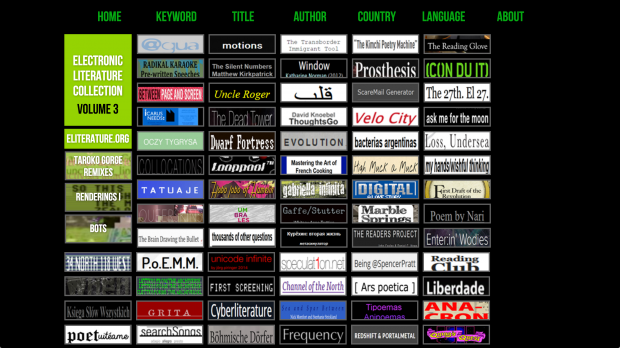In the golden age of electronic books (or e-books), the phones, pads, tablets, and screens with which we read have become ubiquitous. In hand around the house or emerging from pockets on trains and planes, propped up on tables at restaurants or on desks alongside work computers, electronic books always seem to be within arms reach in public and private spaces alike. As their name suggests, however, the most prevalent e-books often attempt to remediate the print codex. Rather than explore the affordances and constraints of computational processes, multimodal interfaces, network access, global positioning, or augmented reality, electronic books instead attempt to simulate longstanding assumptions about reading and writing. Nevertheless, the form and content of literature are continually expanding through those experimental practices digital-born writing and electronic literature. Electronic literature (or e-lit) occurs at the intersection between technology and textuality. Whereas writing is a five thousand year old technology and the novel has had hundreds of years to mature, we do not yet fully know what computational and programmable media can do and do not yet fully understand the expressive capacities of electronic literature. In this respect, e-lit does not operate as a fixed ontological category, but marks a historical moment in which diverse communities of practitioners are exploring experimental modes of poetic and creative practice within our contemporary media ecology. If we define literature as an artistic engagement of language, then electronic literature is the artistic engagement of digital media and language. Such works represent an opportunity to consider both the nature of text as a form of digital media--as a grammatization or digitization of otherwise unbroken linguistic gestures--as well as the algorithmic, procedural, generative, recombinatorial, and computational possibilities of language. The history of e-lit includes projects that may not be labeled by their authors as part of this literary tradition and, in fact, some of the most compelling engagements are found in animation, videogames, social media, mobile applications, and other projects emerging from diverse cultural contexts and technical platforms. The Electronic Literature Organization (ELO), founded in 1999, has released two volumes collecting works of significance to the field: the ELC1 (http://collection.eliterature.org/1/) in 2006 and the ELC2 (http://collection.eliterature.org/2/) in 2011. Following this five-year tradition, the Electronic Literature Collection Vol. 3 (ELC3) continues the legacy of curating and archiving e-lit. Since the second volume was published, the rise of social media and increased communication between international communities has brought attention to authors and traditions not previously represented, while authors outside traditional academic and literary institutions are using new accessible platforms (such as Twitter and Twine) to reach broad audiences with experimental forms of both human and nonhuman interaction. As such, the editors of the ELC3 seek to expand the perceived boundaries of electronic literature. In 2015, we disseminated an open call inviting communities from across the web and across the globe to submit their work to this this collection. And although many of the submitted works were produced very recently, we also looked backward and included a number of historical selections reflecting work that was not yet part of the discussion of electronic literature when the previous volumes were curated. The ELC3 features 114 entries from 26 countries,13 languages, and including a wide range of platforms from physical interfaces and iPhone apps to Twitter bots and Twine games to concrete Flash poetry and alternate reality games to newly performed netprov and classic hypertext fiction. By pulling projects from these different spaces and times into the same collection, the ELC3 aims not only to preserve a diverse set of media artifacts but to produce a genealogy that interleaves differing historical traditions, technical platforms, and aesthetic practices. Many of the works in this collection are already endangered bits. Some of the platforms that supported them, such as Adobe Flash and the Unity 3D web player, are quickly becoming outmoded by new standards while material platforms like mobile phones and touch-screen tablets, are always on the cusp of new upgrades and models. This archive attempts to capture and preserve ephemeral objects by including textual descriptions and video documentation along with the source materials that offer a glimpse into the underlying structures of each work. Although metadata and paratexts cannot substitute for the original experience of a work, supplementary media delays the inevitable. Both the greatest threats to the field of electronic literature and its pharmacological raison d'etre is the rapid progression and newness of new media itself. As editors, curators, archivists, and creators ourselves, we hope to preserve some of this history and provide new generations of scholars, authors, and readers with insight into the ongoing experiments in the electronic literature. The Electronic Literature Collection Vol. 3 is not the end of e-lit. Nor is it necessarily the beginning of a new chapter of its history. The ELC3 is a mirror of a specific moment in time occurring across continents, languages, and platforms during the second decade of the twenty-first century. This collection parallels the works collected, operating in symbiotic relation with programs and processes, images and texts, readers and writers—and you. —Stephanie Boluk, Leonardo Flores, Jacob Garbe and Anastasia Salter (Source: http://collection.eliterature.org/3/about.html)


